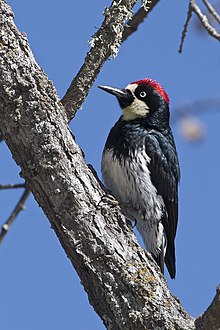Acorn woodpecker
| Acorn woodpecker | |
|---|---|
 |
|
| Male in California, United States | |
 |
|
| Female in Arizona, United States | |
| Scientific classification | |
| Kingdom: | Animalia |
| Phylum: | Chordata |
| Class: | Aves |
| Order: | Piciformes |
| Family: | Picidae |
| Genus: | Melanerpes |
| Species: | M. formicivorus |
| Binomial name | |
|
Melanerpes formicivorus (Swainson, 1827) |
|
 |
|
| Range of M. formicivorus | |
The acorn woodpecker (Melanerpes formicivorus) is a medium-sized woodpecker, 21 cm (8.3 in) long, with an average weight of 85 g (3.0 oz).
The adult acorn woodpecker has a brownish-black head, back, wings and tail, white forehead, throat, belly and rump. The eyes are white. There is a small part on the small of their backs where there are some green feathers. The adult male has a red cap starting at the forehead, whereas females have a black area between the forehead and the cap. The white neck, throat, and forehead patches are distinctive identifiers. When flying, they take a few flaps of their wings and drop a foot or so. White circles on their wings are visible when in flight. Acorn woodpeckers have a call that is almost like they are laughing.
The breeding habitat is forested areas with oaks in the hills of coastal areas and foothills of California and the southwestern United States south to Colombia. This species may occur at low elevations in the north of its range, but rarely below 1,000 m (3,300 ft) in Central America, and it breeds up to the timberline. The breeding pair excavate a nest in a large cavity in a dead tree or a dead part of a tree. A group of adults may participate in nesting activities: field studies have shown that breeding groups range from monogamous pairs to breeding collectives of seven males and three females, plus up to 10 nonbreeding helpers. Young from a single brood have been found with multiple paternity.
Acorn woodpeckers, as their name implies, depend heavily on acorns for food. In some parts of their range (e.g., California), the woodpeckers create granaries or "acorn trees" by drilling holes in dead trees, dead branches, telephone poles, and wooden buildings. The woodpeckers then collect acorns and find a hole that is just the right size for the acorn. As acorns dry out, they are moved to smaller holes and granary maintenance requires a significant amount of the bird's time. They also feed on insects, sap, and fruit.
The acorns are visible, and the group defends the tree against potential cache robbers like Steller's jays and western scrub jays. Acorns are such an important resource to the California populations that acorn woodpeckers may nest in the fall to take advantage of the fall acorn crop, a rare behavior in birds. Acorn woodpeckers can also be seen sallying from tree limbs to catch insects, eating fruit and seeds, and drilling holes to drink sap. The acorn woodpecker will use any human-made structures to store acorns, drilling holes into fence posts, utility poles, buildings, and even automobile radiators. Occasionally the woodpecker will put acorns into places where it cannot get them out. Woodpeckers put 220 kg (490 lb) of acorns into a wooden water tank in Arizona. In parts of its range the acorn woodpecker does not construct a "granary tree", but instead stores acorns in natural holes and cracks in bark. If the stores are eaten, the woodpecker will move to another area, even going from Arizona to Mexico to spend the winter.
...
Wikipedia

